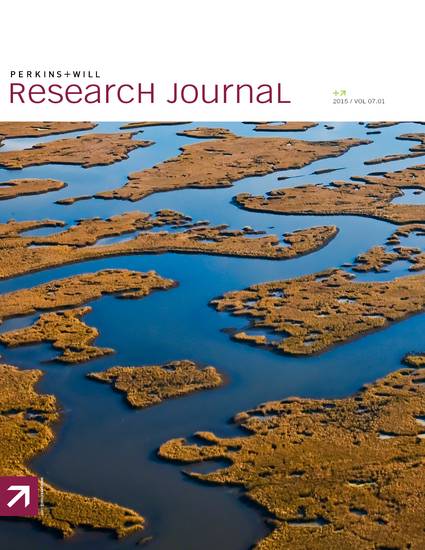
Other
Perkins and Will Research Journal Vol. 7 No. 1
(2015)
Abstract
This issue of Perkins and Will Research Journal includes four articles that focus on different research topics, such as open building design concept for residential building typologies, framework for resilient design, simulations and modeling for healthcare design, and urban design methods for making coastal cities more resilient to climate change.
“Building Resilience: A Framework for Assessing and Communicating the Costs and Benefits of Resilient Design Strategies” discusses the development of a framework for resilient building design. The article analyzes existing resilience assessment framework for disaster mitigation, and offers a new methodology that integrates sustainability and climate change factors for developing a more inclusive framework for evaluating building resilience including economic factors. The framework has been evaluated using two case study buildings. The conclusions indicate that resilient design offers many benefits, both quantifiable and qualitative (energy savings, improved health, and productivity of building occupants), and that further research is needed that expands beyond building resiliency to urban scale.
“Developments in Residential Open Building: Analysis and Reflections of Two Seminal Case Studies” discusses open building concept for multi-family residential architecture, focusing on in-depth analysis of two specific case study buildings. The core principle of the residential open building concept is that the housing must accept change and transformation, and must include the users and building occupants in the decision-making process. By examining two specific case studies, this articles exposes the possibilities and limitations of this particular design concept. The paper also analyzes user involvement in the design process, opportunities, and the benefits of adaptable construction.
"Simulation Modeling as a Lean Tool for Healthcare Design: Determining Room Utilization and Staffing in the Emergency Department” focuses on operational planning and simulation modeling for the design of healthcare facilities. The article outlines the process conducted for the design of an emergency department, where room utilization and staffing were examined based on the current and projected number of patients. A simulation model was developed to simulate patient flow, where patient wait times, census, and staffing rations were used as the key metrics to evaluate the efficacy of the emergency department design. The results were used to determine design scenarios that would better use the space and reduce patient wait times.
“Shrinking Wetlands, Sinking Cities: Why Preserving and Restoring Wetlands Can Help Save Our Coastal Cities” provides insight into effects of climate change and sea waters rise on coastal cities and possible mitigation through preservation and restoration of wetlands. The article includes a literature review, in-depth analysis of two case studies, and also defines next steps and necessary research for wider adoption.
Keywords
- Practice-based design research,
- Architecture,
- Design
Disciplines
Publication Date
June 1, 2015
Citation Information
Ajla Aksamija and Kalpana Kuttaiah. "Perkins and Will Research Journal Vol. 7 No. 1" (2015) Available at: http://works.bepress.com/ajla_aksamija/167/
